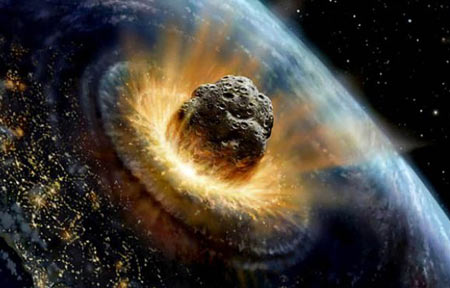|
 A chunk of rock 400 times the City of London is set to hurtle closer than a rock of its size has in a very long time. |
|
Scientists are trying to find a way to protect Earth from the giant rocks which travel around the Milky Way. Run out of Berlin with funds from the EU, the NEOShield project, which will look for a way to protect earth from the space rocks, is expected to take three years to complete. Some of the ideas being tossed around at the moment include repelling asteroids with projectiles or explosives or using gravity to change its course. The project though is a little late as a chunk of rock 400 times the City of London is set to hurtle closer than a rock of its size has in a very long time. The asteroid labelled ‘(433) Eros’ measures 19 by 8 by 8 miles and is set to pass by next week. Despite its massive size, the cosmic rock shouldn’t be too cause too much of a threat as it is on a circular path far outside the moon's orbit. Nevertheless, with NASA estimating that there are almost one thousand asteroids over one kilometre in length and 19,500 over 100-metres, scientists at the Institute of Planetary Research are trying to find a way to protect Earth. With an investment of some €4 million by the European Commission and an extra €1.8 million coming from scientific institutions and partners, the German Aerospace Center aims to have a plan for a test mission drafted within three years. After that, if they can find the extra cash, the mission may be launched by 2020. The scientists will be looking at a host of ideas, many of which have already been proposed. 'Of course, a lot of things have already been proposed,' Alan Harris, the study’s leader, told Spiegel Online. ‘But, so far, most of them have come from a single institution, perhaps even from a single person. So it has been hard to pursue them.’ Investigating each idea ‘will take place on paper and in lab experiments, since we don't have the money to do more than that,’ said Wolfram Lork, who works with a subsidiary on the project. One other, coarser idea would be ‘blast deflection’ which would involve deterring the asteroid with directed explosive charges. Harris says this would be the ‘final, desperate approach.’ (Read by Emily Cheng. Emily Cheng is a journalist at the China Daily Website.) (Agencies) |
科学家正试图找到能保护地球免遭银河系巨石撞击的方法。 欧盟出资赞助的这一“小行星防护盾”项目从柏林起步,目标是寻找一种能保护地球免遭太空巨石撞击的方法,该项目预期将耗时三年完成。 当前考虑的一些思路包括用导弹、炸药来击退小行星或运用地心引力来改变小行星的运行轨道。 不过,这一项目开始得有点晚,因为一块相当于400个伦敦城的巨石正向地球逼近,而且是很长时间以来这么大的巨石和地球最近距离的接触。 这一号称(433) Eros的小行星大小为19*8*8英里,将于下周和地球擦肩而过。 尽管这一太空巨石体积很大,但应该不会对地球造成太大威胁,因为该巨石沿着月球轨道之外距离较远的一个圆形轨道运行。 然而,美国宇航局估计现在银河系约有1000颗长度超过1千米的小行星和19500颗长度超过100米的小行星,因此行星研究所的科学家们正努力探寻保护地球的办法。 对此欧盟委员会已投入400万欧元,此外科学机构及合作伙伴也投入了180万欧元。德国宇航中心致力于在三年内用这些资金指定出一个测试任务的计划。 在那之后,如果还有更多资金来源,他们可能会在2020年前执行这一任务。科学家将考虑许多构想,包括之前提出过的众多建议。 该研究的领头人阿兰•哈里斯告诉Spiegel Online说:“当然,人们已经提出了许多构想。但是,到目前为止,大多数构想都是来自单个机构,甚至也许是单个人提出来的。所以想实行这些构想很困难。” 该项目辅助机构研究员沃尔夫拉姆•洛克说,对每个构想进行调查研究“将会在论文和实验室层面上进行,因为我们没有经费去做更多的事”。 另外一个粗略构想是“爆炸偏移”,也就是通过导弹爆炸偏移小行星的运行方向。哈里斯说,这将会是“铤而走险的最后一招”。 相关阅读 (中国日报网英语点津 陈丹妮 编辑:Julie) |
|
Vocabulary: NEO: near earth orbit 近地小行星 repel: 击退 asteroid: 小行星 projectile: 导弹,射弹 cosmic: 宇宙的 deflection: 偏斜;偏向 deter: 拦住 |
